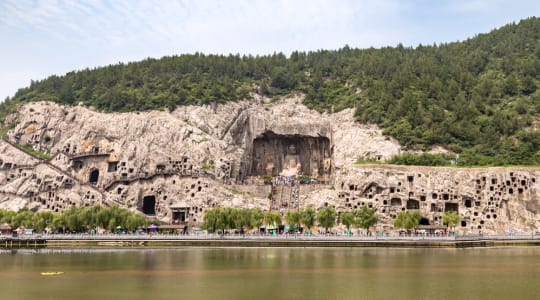The Longmen Grottoes, also known as the Longmen Caves, are a series of Buddhist rock-cut caves and temple ruins located in the city of Luoyang, Henan Province, China. The caves are situated along the banks of the Yi River and are considered one of the finest examples of Chinese Buddhist art and architecture.
The Longmen Grottoes were created during the Northern Wei Dynasty (386-534 AD), and continued to be a site of Buddhist activity until the Tang Dynasty (618-907 AD). Over the centuries, more than 100,000 Buddhist statues and inscriptions were carved into the cliffs, making it one of the largest and most impressive collections of Buddhist art in China.
The main attraction of the Longmen Grottoes is the collection of over 2,100 Buddhist statues, including some of the largest and most detailed examples of Chinese Buddhist art. The statues range in size from just a few inches to over 100 feet tall, and are made from a variety of materials, including stone, wood, and metal. The largest and most famous statue is the 81-foot-tall statue of the Buddha, located in the central cave.
The Longmen Grottoes also feature a number of temples and monasteries, as well as numerous inscriptions and rock carvings. In 2000, the Longmen Grottoes were designated as a UNESCO World Heritage Site, in recognition of their importance as a cultural and historical monument.
Visitors to the Longmen Grottoes can take a guided tour of the caves, and can also explore the nearby temples and monasteries. In addition, there are several museums and visitor centers near the caves, where visitors can learn more about the history and significance of the Longmen Grottoes.
Explore Near Longmen Grottoes
Discover 1 attraction, 5 cities, and 1 airport within 75km. Perfect for planning day trips, finding connecting flights, or discovering new destinations to explore during your visit.
Nearby Attractions & Places to Visit
1 destination within 52.1km from your location

Nearby Cities Worth Exploring
5 destinations within 13.4km - 60.3km from your location
Airports Near Longmen Grottoes
1 destination within 21.9km from your location
Cross-Border Adventures Near Longmen Grottoes
Discover cross-border adventures near Longmen Grottoes. Explore neighboring countries with similar attractions and extend your travel experience across borders.








And 8 more neighboring countries

